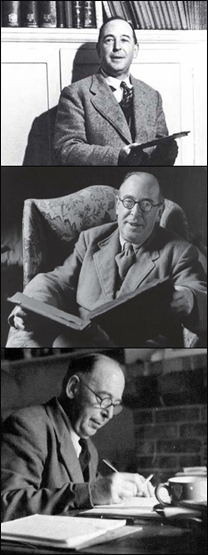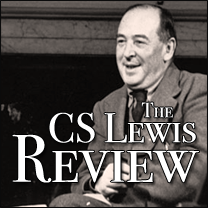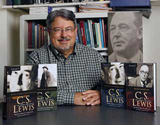
Jack's "Personal Heresy": The Politics of Poetics
March 20th, 2008 | Skip to comments
The Personal Heresy is another important work in Lewis’s canon that few people outside of literary studies will have noticed, but one whose impact in accounting for Lewis’s journey of faith and the role of “objective value” in his thinking cannot be underestimated.
 “The Personal Heresy” refers both to (1) a menacing concept C. S. Lewis identified early in his professional career as debilitating to effective criticism and true understanding of poetry and art, and also, (2) the title of a 1939 publication collecting the celebrated exchange between Lewis and then renowned Milton scholar, E. M. W. Tillyard on this topic. (It’s alleged that Tillyard, whose first name was “Eustace,” may have been the model for the eponymous Pevensie cousin who journeys on The Voyage of the “Dawn Treader,” and helps save the day in The Silver Chair.)
“The Personal Heresy” refers both to (1) a menacing concept C. S. Lewis identified early in his professional career as debilitating to effective criticism and true understanding of poetry and art, and also, (2) the title of a 1939 publication collecting the celebrated exchange between Lewis and then renowned Milton scholar, E. M. W. Tillyard on this topic. (It’s alleged that Tillyard, whose first name was “Eustace,” may have been the model for the eponymous Pevensie cousin who journeys on The Voyage of the “Dawn Treader,” and helps save the day in The Silver Chair.)
The latter debate, consisting of three essays each from the two controversialists and a final note from Lewis, stands as a useful compendium of Lewis’s early objectivist views of what constitutes the act of composing and the criticism appropriate to poem and poet. (Here “poem” and “poet” refer not just to the genre of “poetry” as it is normally understood, but rather to any imaginative work or “maker” of art, irrespective of genre.)
Simply put, “the personal heresy” is Lewis’s label for a stance he vigorously opposed, namely, that poetry is first and foremost the “expression of the poet’s personality.” What follows from such a premise, Lewis avers, is that a reader of a poem purportedly learns as much about the poet as he or she does about the subject matter or theme of the poem itself; inevitably, the brand of criticism most likely to be fruitful in illuminating the poem will be prohibitively biographical or psychological. This is anathema to Lewis.
In the early 1930s, Lewis found this stance, pervasive in E. M. W. Tillyard’s 1930 work, Milton, to be a growing menace to responsible criticism and readership. The working premise of Tillyard’s work confounded Lewis: “all poetry is about the poet’s state of mind.”
Its accompanying, highly foregrounded propositions further perturbed Jack: (1) that to understand Paradise Lost aright one must read it as an “expression of Milton’s personality,” and that, therefore, (2) “the end we are supposed to pursue in reading . . . is a certain contact with the poet’s soul.” These are all inimical to Lewis’s own disposition toward and understanding of the poetic act and the proper role of critics.
The poet is not a man who asks me to look at him; he is a man who says ‘look at that’ and points; the more I follow the pointing of his finger the less I can possibly see of him.
Consequently, for Lewis, the critic’s role is neither to reconstruct the poet’s psyche between the lines of the poem nor to deconstruct the poem as concealed biography; rather, it is to help the reader see with ever greater clarity the world depicted in and through the poem that the poet has intentionally composed. As Lewis observes, “there is no essential qualification for criticism more definite than general wisdom and health of mind.”
Lewis’s formulation of the “personal heresy” had, in fact, a long gestation, first surfacing in a presentation he made in the summer of 1924 to the Martlets, an undergraduate Oxford literary society. In his remarks, Lewis maintained that the biography of James Stephens, a popular Irish writer of the time, had nothing to do with understanding or appreciating the meaning of his works–and, in fact, could diminish it. Six years later, Lewis addressed the Martlets once again, but this time as a don and not as a student, having fully conceptualized the malady he believed plagued contemporary criticism.
This address, entitled, “The Personal Heresy in Poetics,” began with Lewis’s critique of an advertisement for a war-time poetry anthology that purportedly would inform readers of private feelings associated with tramautic events that not even soldiers’ loved ones could discern. The reader was compelled to infer that the soldier-poet would unwittingly “reveal” something of his psychological state as it were, through his poems, something could be discovered and articulated quite apart from the actual content of the poems themselves.
Characteristically, Lewis regarded this facile equation of the poet’s mental state with the submerged subject matter of the poems more than appalling; it made the force of authorial intent and the ability to see through his eyes impossible. His attack on this dubious notion would remind many readers of his critique in The Abolition of Man (1943) of “The Green Book,” a collegiate composition textbook he believed undermined “objective value” in education and taught readers to reduce all comprehension to the bundle of feelings that their reading material evoked in them. To accept this premise, Lewis believed, is to destroy the very purpose of reading poetry or anything else (a theme taken up in his last work of literary criticism, An Experiment in Criticism).
After this provocative introduction, Lewis proceeded to link this serious but popularized misconstrual with what he regarded as Tillyard’s more insidious theorizings in his book on Milton. Because Tillyard’s academic work was more intellectually respectable than mere advertisements, Lewis believed it could convince a generation of readers and critics that Milton’s own expressed intention, “to justify the ways of God to man,” should be ignored or supressed. And thus we would never “see what the poet saw.”
Lewis’s verbal presentation first took published form in 1934 in the form of an “open letter” appearing in the journal, Essays and Studies, and was followed by a reply from Tillyard in the same journal 1935; an exchange occurred between them in alternating years through 1937, and were eventually collected under the title, The Personal Heresy: A Controversy in 1939.
Tillyard’s response to Lewis consists primarily of defenses of his conception of criticism against the caricature he believed Lewis had created; Tillyard contends that Lewis unfairly reduces his notion of the “poet’s state of mind” merely to the trivial details of a poet’s life. Rather, Tillyard clarifies, in speaking of the poet’s mental state, he is including the whole social and historical context out which a poet speaks and how he reflects his own era, and that this is, indeed, the proper province of modern criticism.
Collegially, Tillyard attempts to find common ground with Lewis where he can, but resists, finally, Lewis’s near total rejection of all aspects of psycho-biographical modes of criticism. By the end of the exchange, Lewis has expressed gratitude for the chance to sharpen his own points of view, but only has conceded some minor points of disagreement with Tillyard on terminology. Lewis’s final “refutation” of Tillyard’s key operating principles as a Milton critic would eventually be offered, in effect, in Lewis’s A Preface to Paradise Lost (1942).
Lewis’s response to Tillyard in The Personal Heresy is of a piece with much of his discourse in the 1930s and 1940s, although Owen Barfield, Lewis’s intellectual companion and mentoring friend through most of his professional career, chided Lewis for his uncharacteristic use of “pastiche,” even tu quoque argumentation, in his exchange with Tillyard, suggesting that there was too much posturing on Lewis’s part– something Lewis rarely descended to in his public lectures and debates.
But in subject matter and focus, The Personal Heresy does exemplify what would become Lewis’s consistent themes in all of his post-conversion nonfiction work, championing as it does the cogency of the doctrine of objective value, opposing the relativistic mindset ascendant in modernist Western culture, and directing his readers attention to the concreteness of a real world that cannot be wished away. Lewis here and elsewhere associated the biographical and psychological criticism of his times with a resurgent gnosticism that denied the reality to which a poem pointed, and mistakenly and triumphantly affirmed in its place the substitute world of the critic’s reconstructions.
Lewis’s strongest and morst controversial contention in The Personal Heresy is that:
when we read poetry as poetry should be read, we have before us no representation which claims to be the poet, and frequently no representation of a man, a character, or a personality at all.
Lewis is interested in the reader being able to meet the poem on the landscape of an accessible and stable text provided by the poet; for him, “poetry that is only ‘about’ the poet’s state of mind,” deprives the reader of a true text, a true world, and thus denies him or her a means of transcendence, which is for Lewis the chief value of reading.
A text which is equivalent in some sense to its author’s psyche–like a text which is in some sense equivalent to its reader’s psyche–dissolves the crucial object/subject distinction that makes personal encounter possible, and which Lewis cherishes as a philosopher/critic.
Even when the “personal heresy” is not pushed to its logical extremes, Lewis believed it inevitably nurtures a brand of criticism and a type of reading which inevitably calls for “experts,” and thus robs the general or “innocent” reader of the most essential feature of readerly experience, i.e., a primary confrontation with a textual world offered by a real self.
During the last decade of his life, it seems to me that Lewis softened somewhat the stridency of the objectivism apparent in The Personal Heresy, finding a considerable role for the reader in constructing meaning (and incarnating him- or her self) inside the text, and for the author who “discovers” the meaning of his work and the presence of his intentions by composing the work.
This emerging new framework for understanding the value and purpose of reading is reflected in his last novel, Till We Have Faces (1956), and codified in his last sustained and focused critical work, An Experiment in Criticism (1961).
NEWS FLASH:
The Personal Heresy Back in Print!
The Personal Heresy: A Controversy is available this summer from Concordia University Press in its first reprint since its original publication in 1939.
The Personal Heresy: A Controversy comprises the exchange of essays between C. S. Lewis and E. M. W. Tillyard discussed above; I am privileged to contribute the Foreword to the work.
ORDERING INFO:
To order your pre-publication copy by August 1 and avoid shipping and handling, send $19.95 to Dr. Joel Heck, Concordia University Press, 3400 N. Interstate 35, Austin, Texas 78750, with a check payable to “Concordia University Press.” For more information or for a quantity discount, e-mail Joel Heck at HeckYes@aol.com. After August 1, include $4.00 for shipping and handling within the contiguous forty-eight states, or US$6.00 outside the forty-eight states.




Spectacular post, and much needed. The Personal Heresy has slipped through the cracks. It isn’t reprinted, so nobody reads it, so there are few copies, so it is expensive, so nobody reads it, so it isn’t reprinted, so there are few copies. . .etc, etc, etc, ad nauseum! Sad, isn’t it?
I hope you don’t mind, but I’ve put up a link to this blog post at the Wikipedia page for TPH. The page was nothing but a single sentence previously, and information like this blog post was sorely needed.
Comment by Bob — 20 March 2008 @ 2:18 PM
Did you see that TPH is being reprinted by Concordia University Press this coming summer? I was pleasantly surprised to stumble on the fact!
http://www.concordia.edu/html/newsevents/article.cfm?newsID=1013
Comment by Bob — 27 May 2008 @ 5:04 PM
Yes, Bob! The Personal Heresy Back in Print!
The Personal Heresy: A Controversy is available this summer from Concordia University Press in its first reprint since its original publication in 1939. I am contributing the Foreword to the work. To order a pre-publication copy by August 1 and avoid shipping and handling, send $19.95 to Dr. Joel Heck, Concordia University Press, 3400 N. Interstate 35, Austin, Texas 78750, with a check payable to “Concordia University Press.” For more information or for a quantity discount, e-mail Joel Heck at HeckYes@aol.com. After August 1, include $4.00 for shipping and handling within the contiguous forty-eight states, or US$6.00 outside the forty-eight states.
Comment by Bruce — 30 May 2008 @ 7:24 AM